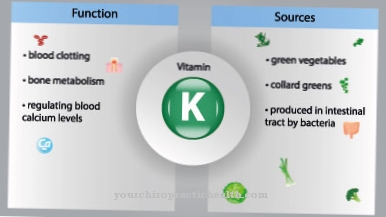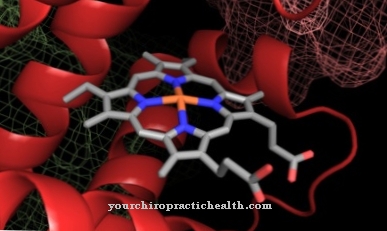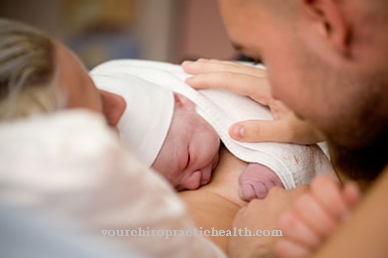Thrombocytopenia, the lack of platelets in the blood, can result from various causes. Thrombocytopenia often occurs only in a weak form and does not require treatment, as the body can usually regulate the deficiency itself. The different types of thrombocytopenia have different symptoms and treatment options.
What is thrombocytopenia?

© timonina - stock.adobe.com
The Thrombocytopenia means too little of platelets called thrombocytes in the blood. While the human body normally has around 150,000 - 450,000 platelets per µl of blood, this value is not reached in the case of thrombocytopenia. A distinction is made between congenital, acquired, and artificially induced thrombocytopenia, with congenital thrombocytopenia only rarely occurring.
Small deviations in the usual number of platelets usually do not lead to noticeable damage in the body. However, if the number of platelets is far below the limit, there may be visible damage and failure symptoms at around 10,000 platelets per µl of blood or even less.
causes
The causes of thrombocytopenia are different. One cause could be that the bone marrow is not able to produce enough platelets or that the body's immune system is fighting the platelets. Another possible cause is an enlarged spleen in which too many platelets are filtered out.
Since the spectrum of causes of thrombocytopenia is very large, they are generally divided into 3 categories: educational disorders, accelerated breakdown of platelets and distribution disorders. In many cases, thrombocytopenia is not chronic, but only occurs temporarily until the body has regulated the deficiency by itself.
Severe thrombocytopenia occurs in most cases in connection with autoimmune diseases, chemotherapy or the use of special medications and should be monitored by a doctor and treated if necessary.
Symptoms, ailments & signs
Thrombocytopenia does not show itself with general signs in the initial phase. Even with significantly reduced blood values, the patients initially show no disruption to their wellbeing. A typical symptom of the disease is the bleeding behavior with small cuts, abrasions or scratches.
The low levels of blood platelets slow down the natural closure of the skin vessels. While five to six minutes are usual for healthy people, it takes two to three times longer for those affected. Some of the sick tend to bleed from the nose or gums more often.
Other common complaints are small, red spots and bloody spots in the subcutaneous tissue. Others get bruises noticeably quickly, which can be seen from harmless bumps. In women, there are also specific symptoms. Here it is the period that is sometimes longer than usual.
If the laboratory data on the platelets are noticeably low, the bleeding tendency can widen significantly. In these less common cases, bleeding mucous membranes form. If severe, they lead to dangerous gastrointestinal and other internal bleeding. Patients can tell by the colored stool or urine. Individual cases of cerebral haemorrhage are immediately life-threatening.
The various symptoms of thrombocytopenia spread at different rates. It largely depends on which diseases of the patient the disorder is associated with.
Diagnosis & course
Depending on the degree of Thrombocytopenia the body has various symptoms. In the case of small deviations, the body does not usually show any tendency to bleed, but in individual cases increased bleeding may occur in connection with injuries.
With advanced thrombocytopenia, there are more bruises, so-called microtraumas, and punctiform skin bleeding on sensitive parts of the body. Severe thrombocytopenia is primarily characterized by frequent spontaneous bleeding of the skin and mucous membranes.
Depending on the type of thrombocytopenia, bleeding in the brain and intestine, venous and arterial thrombosis or even infarcts and pulmonary embolism can occur without therapy.
Complications
In general, thrombocytopenia has a very negative effect on the everyday life and quality of life of the person concerned. The exact symptoms and complications of this disease depend very much on the severity of the thrombocytopenia. Those affected primarily suffer from bruises or bruises. These can occur in different parts of the body and may also lead to aesthetic complaints for the patient.
Furthermore, those affected often suffer from bleeding gums or nosebleeds and are therefore restricted in their everyday life. Inflammation or pain can also occur. Furthermore, thrombocytopenia increases the risk of a heart attack or an embolism, so that the person affected can also die from these symptoms. However, this case only occurs very rarely.
Treatment of thrombocytopenia always depends on the cause. As a rule, there are no particular complications and the symptoms can be limited. Transfusions may also be necessary. The further course, however, depends strongly on the underlying disease. It cannot be universally predicted whether the thrombocytopenia will lead to a reduced life expectancy for the patient.
When should you go to the doctor?
If nosebleeds occur repeatedly or bruises develop, the cause may be thrombocytopenia. A doctor's visit is indicated if the symptoms appear for no apparent reason or if other symptoms such as blood in the stool, urine or cough are added. If bleeding cannot be stopped, punctiform bleeding occurs in the skin or a general malaise is noted, medical advice is needed. Patients at risk include people who have had a blood transfusion, suffer from acute respiratory distress syndrome or a disease of the connective tissue.
Drugs, infections, or medical complications such as sepsis can also cause thrombocytopenia. Every 20th pregnant woman suffers from asymptomatic thrombocytopenia in the last trimester, which must also be investigated and treated quickly. Thrombocytopenia is treated by your family doctor or cardiologist. In the case of serious illnesses such as sepsis or rickettsial infections, the emergency doctor must be called. Because people are anemic, they need to respond quickly to prevent major health complications.
Treatment & Therapy
Treatment of Thrombocytopenia depends on the underlying cause. Thrombocytopenia that occurs only acutely disappears by itself after a few weeks and is usually not treated. Acute thrombocytopenia, on the other hand, can last for several years and is classified and treated based on the cause, the degree of bleeding and the platelet count.
Treatment of thrombocytopenia focuses on stopping the bleeding of the skin and mucous membranes using medication and reducing factors that promote bleeding, as well as increasing the number of platelets so that no new bleeding occurs. If the symptoms indicate a frequent tendency to bleed, hospitalization and observation are recommended. If internal bleeding is suspected or if chronic bleeding occurs, emergency treatment may be required.
In severe chronic symptoms, platelets are transfused and added to the bloodstream. Another possible therapy is the removal of the spleen, although the removal of organs is increasingly rejected due to long-term risks and susceptibility to infection. Another possibility is the administration of special antibodies or synthetic peptides that stimulate the formation of platelets.
You can find your medication here
➔ Drugs for wound treatment and injuriesprevention
There are currently no known preventative measures for one Thrombocytopenia. In severe cases of thrombocytopenia, early detection and early treatment of symptoms can help regulate platelet deficiency as quickly as possible.
If spontaneous bleeding occurs more frequently than normal, such as nosebleeds and bleeding gums or small punctiform skin bleeding on the body, a doctor should be consulted. The possibility of thrombocytopenia increases particularly in connection with pregnancy, the use of heparin to inhibit blood clotting and during chemotherapy.
Aftercare
In most cases, those affected have only limited follow-up measures available for thrombocytopenia, as it is a rare disease. If the disease has been present since birth, it usually cannot be completely cured. Therefore, if the person concerned wants to have children, they should undergo genetic testing and counseling in order to prevent the disease from recurring.
As a rule, there can be no independent healing. Most of those affected are dependent on an operation. After such an operation, the patient should definitely rest and take care of his body, maintaining strict bed rest and avoiding stressful or physical activities.
In many cases, the support and help of one's own family is also necessary to avoid depression or psychological upset. It cannot be universally predicted whether thrombocytopenia will lead to a reduced life expectancy for those affected. It is often useful to have contact with other sufferers of the disease, as this can lead to an exchange of information.
You can do that yourself
A balanced diet helps to noticeably increase the number of platelets. Fresh vegetables and fruits stimulate your own production of new blood platelets. Food like oranges, tomatoes, kiwis and green vegetables have a particularly positive effect. In contrast, processed foods like sugar and flour, as well as cookies and soda, affect the body's vital clotting function.
High quality omega-3 fatty acids can stimulate the production of blood platelets. It is therefore particularly advisable to eat more fatty fish such as salmon or mackerel, rapeseed oil or linseed oil, as well as the consumption of eggs and nuts. In order to increase platelets, those affected should also watch their drink consumption. It is particularly recommended to avoid alcohol and beverages containing caffeine. Instead, lukewarm water stimulates nutrient absorption in the body. As a result, more blood cells are produced. Green tea, white ginseng and olive leaves also have a positive effect on the production of blood platelets.
In addition to a balanced diet, exercise can stimulate the production of platelets. Exercise strengthens the immune system and the circulation. This helps the body produce the platelets it needs more easily. But it is important to choose the sport carefully. Because patients tend to bleed profusely. For this reason, contact sports should be avoided. Gentle endurance training is better.













.jpg)

.jpg)
.jpg)











.jpg)